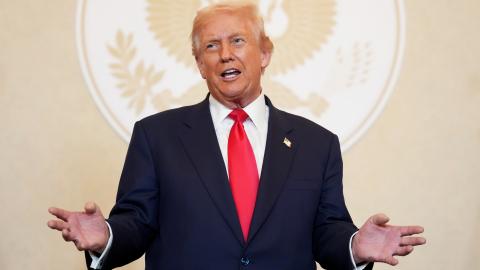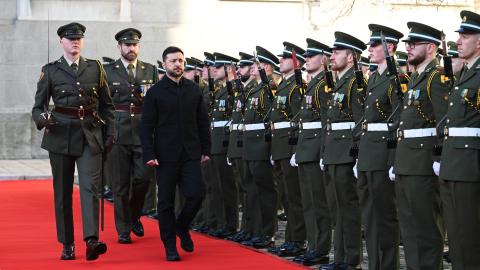The pandemic that began in, and spread from, China will lead to serious, linked financial and security challenges for the United States. As America looks at cutting its defense budgets to help prevent an economic catastrophe, China’s weapons modernization of the past 25 years continues: The South China Morning Post reported on May 20 that Chinese military leadership will seek “a substantial increase in their budget” at the annual National People’s Congress.
The idea that U.S. defense spending greatly outpaces China’s is outdated. The Chairman of the Joint Chiefs General Mark Milley told Congress in 2018, while he was Army Chief of Staff, that if the high personnel cost of the All-Volunteer Force is subtracted from the U.S. defense budget, Chinese (and Russian) spending on new weapons and other significant categories of military preparedness is very close to our own. Studies commissioned by the U.S. Defense Department and Stockholm International Peace Research Institute support this point. When adjusted for Purchasing Power Parity, China’s 2017 military budget could purchase 87 percent of what its American counterpart could obtain. Hence, China is able to add 14 new ships per year to its fleet, compared to America’s average of five ships.
The possibility that the United States will slash its defense budget in response to the pandemic greatly increases the possibility that China will become a genuine military peer competitor, capable, at least, of achieving regional hegemony and ending America’s run as the pre-eminent Pacific power. COVID-19 has prompted a 6.8 percent GDP contraction in China, the first since China began publishing GDP figures in 1992. But this downturn has not cut into Chinese military spending. Indeed, a few days after the South China Morning Post ran its story, the CCP announced at its annual rubber-stamp “National People’s Congress” a military budget increase over the previous year by 6.6 percent—up to $178.2 billion. In other words, China will increase its military budget in the coming year by almost the exact percentage that its GDP is expected to decrease. And this does not account for the Chinese habit of underreporting its military spending—according to the Stockholm International Peace Research Institute’s estimates, China actually spent $261 billion on defense in 2019. Furthermore, China’s defense figures do not include Research and Development spending, and the CCP can list military-industrial sites as “civilian” locations run by de facto or de jure state-owned corporations.
American defense requires a broad structural overhaul. Each of America’s armed services must reorient away from facing down Middle Eastern counterinsurgencies and fighting European ground conflicts, and toward preparing for an Indo-Pacific naval/amphibious confrontation. At sea, where a conflict with China would be fought, the Navy must transition away from reliance on Carrier and Expeditionary Strike Groups to a more evenly distributed and lethal force comprising small surface combat vessels, submarines, and aircraft, armed with long-range missiles and torpedoes—all supplemented by an array of surface, aerial, and submarine drones. For its part, the Marine Corps must become wholly amphibious and better-coordinated with the Navy rather than acting as a makeshift Army Reserve. This means, among other things, trading its tanks and armored vehicles for shore-based anti-air and anti-ship missile platforms. The Air Force needs to invest in range extenders, newer strike platforms, and long-range missiles that both its fighter and attack aircraft can employ. The Army, while maintaining enough capacity to respond to European contingencies, must also optimize for maritime combat, and accept its new role as a supporting force in the Indo-Pacific.
None of these transformations will come cheap, and in the aftermath of COVID-19, the political will to pony up will be hard to muster. President Trump’s 2021 defense budget request is already reflecting this new reality, with its ask of $705.4 billion only one tenth of a percentage point greater than that of 2020. The only silver lining is that in the immediate term, there are ways to make each dollar go further. Getting personnel costs in check is a start.
Since 1969, the U.S. has transitioned to an “All-Volunteer Force,” comprised of the fully professional active-duty military and each branch’s Reserve and Guard systems. This force is more intelligent, better educated, and better paid than any other military in history. This increases combat efficacy. Smarter soldiers are easier to train and more effective on the battlefield, while better-treated and supported soldiers have higher morale than conscripts or lower-paid professionals.
Nevertheless, this system is extremely expensive. The FY 2019 Defense Budget dedicated nearly 40 percent of its funds—$268.5 billion—to personnel payment and benefits. Conscripting the entire U.S. military’s four most junior enlisted ratings (E-1 through E-4) would free up around $16 billion yearly, enough money for four more Virginia-class submarines, or perhaps as many as 1,000 hypersonic missiles. Distributed between the Navy/Marine Corps and the Air Force, it would significantly increase U.S. abilities to deter aggression in the Indo-Pacific.
Professional volunteers should remain the core of the U.S. military, particularly in special forces and combat units that may deploy to smaller-scale contingencies in the Middle East or Eastern Europe. Moreover, the specialized equipment that the Air Force and Navy operates demands an increasingly higher degree of training and education, necessitating a largely-volunteer force. But integrating limited conscription for certain roles would produce significant cost savings.
Indeed, the COVID-19 pandemic presents a unique opportunity to operationalize this. Not since September 11th, 2001 have Americans been faced with a major national crisis. Not since the Cold War has the United States faced a regime so clearly inimical to American interests and values. COVID-19 has reminded many Americans of the basic responsibilities of citizenship. Defending the nation is the most basic form of citizenship, a virtue whose disappearing example can be seen in interviews with aged WWII veterans who are admired but not imitated. The difference between the nonagenarians’ straightforwardly expressed sense of duty and the feelings of many who are old enough to serve today suggests that we are on the spiritual path toward becoming, as Yeats put it, “no country for old men.”
Limited conscription will not re-create the virtue of republican Rome in our society. But the current pandemic is unlikely to be the last one, and a greater level of tolerance for sacrifice will benefit the nation’s spirit as well as its physical ability to defend against a very determined foe. American policymakers, in the executive and elsewhere, would perform a public service to marshal an increased understanding of individual responsibility into a broad-based movement that takes seriously the demands of citizenship.
Read in The American Interest



















